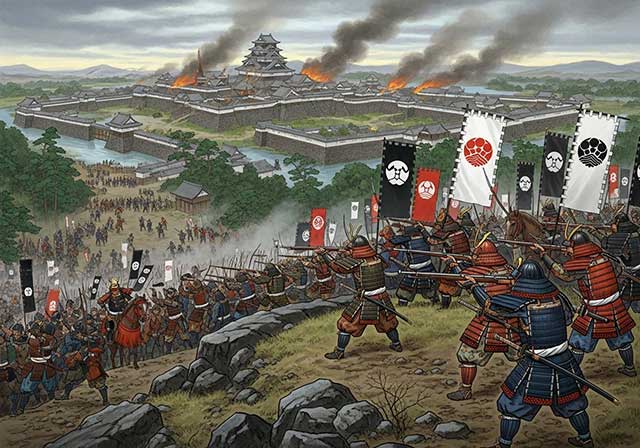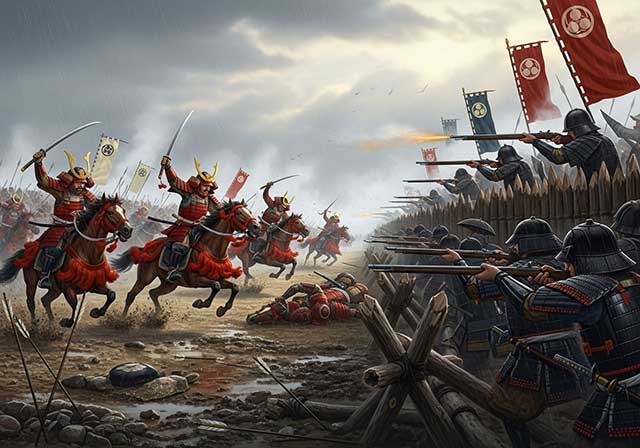
Despite his reputation as a failure, created by 20th-century popular culture, especially cinema, Takeda Katsuyori (1546–1582) was in fact a brave warrior and talented commander. However, he always remained in the shadow of his great father, the legendary Takeda Shingen. After Shingen's death, Katsuyori sought to at least equal him, if not surpass him. Therefore, his actions were not always determined by pragmatic calculation. This character trait greatly influenced the subsequent events that led to the demise of the Takeda clan.
The beginning of the campaign
At the end of May 1575, Takeda Katsuyori left his headquarters in Kai Province and advanced to Mikawa, launching another campaign against his long-time enemy, Tokugawa Ieyasu. Katsuyori's chances of a quick victory were very high, although Shingen's old comrades, who served as advisors to his son, were against the war. Their fears were based on the fact that a significant part of Takeda's army was at that time engaged in a war with Uesugi Kenshin, a very serious opponent. However, the prospect of capturing two provinces at once and defeating Tokugawa Ieyasu seemed worth the risk.
The initial target of the campaign was Okazaki Castle, the main stronghold of the Tokugawa clan. Katsuyori counted on the betrayal of the corrupt official Oga Yasuro, who agreed to open the gates to Takeda's army. Katsuyori's army numbered about 15,000 soldiers, of whom just over 4,000 were horsemen, about 8,500 were foot samurai, and the rest were ashigaru infantry, including about 200 arquebusiers.
However, the conspiracy was soon uncovered, and Oga Yasuro was executed. The attempt to take Okazaki became pointless: the castle had too strong fortifications and garrison. Then Katsuyori decided to send his army to a less significant fortress - Yoshida.
The turn to Nagashino
On June 13, 1575, Takeda's army approached Yoshida Castle, having previously burned down two small satellite forts, Usikubo and Niringi. The attempt to storm Yoshida ended in failure. Moreover, the garrison unexpectedly increased to six thousand men: Ieyasu sent reinforcements under the command of the experienced commander Sakai Tadatsugu. Katsuyori tried to lure the defenders onto the plain, but they did not give in. Unable to maintain a prolonged siege, Katsuyori lifted the siege and moved on. On June 16, he approached Nagashino Castle.
Nagashino Castle
Nagashino was a key strategic point—a kind of northern gateway to the province of Mikawa. Built in 1508, the castle originally belonged to vassals of the Imagawa clan, and then passed to Tokugawa Ieyasu. In 1571, it was temporarily captured by Takeda Shingen, but three years later, the fortress was recaptured.
In 1575, Okudaira Sadamasa became the commander of Nagashino, with about 500 soldiers, including 200 arquebusiers, and a single cannon. The castle was built at the confluence of the Takigawa and Onogawa rivers, which form the Toyogawa River. It was protected on two sides by cliffs and river waters, but the northern and northwestern areas remained vulnerable due to the marshy terrain.
The fortifications included the hommaru (inner bailey) and a number of other baileys — Obiguruwa, Tomoe-guruma, Yagyu-guruma, as well as the outer areas of Hattori-guruma and Fukubemaru. The castle had ramparts, moats, palisades, stone and earthen walls, as well as the Danjogurwa bridgehead fortification.
First attacks
Katsuyori correctly assessed the location of the castle and first captured the fortifications on the hills of Daitsuzayama and Tojiyama. He set up his headquarters on the hill of Iodzayama and surrounded the castle. On June 17, he conducted a reconnaissance in force, and on June 18, a massive assault began.
Takeda's soldiers attacked, using bamboo bundles called taketaba for cover. The defenders fired arquebuses and bows, setting fire to the attackers' shelters. The attackers suffered heavy losses: about 800 men.
On June 19, Katsuyori made an unusual attempt: he built a raft on which a detachment of attackers descended the river. However, the defenders noticed the plan in time, fired at the raft, and threw stones at it. The plan failed.
On June 20, Takeda's warriors launched a night attack from two directions. They managed to break into the outer courtyards, but the garrison retreated deeper into the castle.
The turning point in the siege
On the night of June 21, Takeda's warriors began to erect a siege tower, but in the morning, the defenders destroyed it with a single well-aimed shot from their only cannon. On the same day, gold miners from Katsuyori's army, skilled in digging tunnels, blew up part of the wall. The western wall of the hommaru collapsed, shocking the defenders.
The attack that followed was the most fierce. Tomoe-guruwa and Danjo-guruwa were captured, as well as the supply warehouses. However, they were unable to take the castle completely. Katsuyori switched to a blockade tactic, even blocking the rivers with nets.
The Feat of Torii Sunemon
Okudaira Sadamasa sent a messenger for help. It was Torii Sunemon, an ashigaru and local resident. On the night of June 23, he left the castle and managed to break through the blockade. Upon reaching Okazaki, he informed the allies that supplies would only last three days.
On his way back, Sunemon was captured. Katsuyori suggested that he misinform the garrison, but Sunemon, on the contrary, urged the defenders to hold out until the end. For this, he was executed — either pierced with spears or crucified. His feat aroused admiration even among his enemies.
Military Council
Upon learning of the movement of the allied army to break the siege, Katsuyori convened a council. Shingen's old comrades-in-arms — Baba Nobuharu, Yamagata Masakage, and others — advised retreat. The young generals insisted on a decisive battle. Katsuyori chose battle.
On June 28, 1575, the famous Battle of Nagashino took place on the Shidarahara Plain, in which Takeda's troops suffered a crushing defeat at the hands of the combined armies of Oda and Tokugawa.

The end of the siege
At the same time, a 3,000-strong detachment under the command of Sakai Tadatsugu was sent to Nagashino Castle. Arquebusiers and samurai destroyed Takeda's garrison in the fortifications at Tobigasuyama. Seeing the smoke and hearing the gunfire, the defenders of Nagashino launched a counterattack and inflicted serious damage on the remnants of Takeda's army.
Thus ended the siege of Nagashino Castle, which was the prelude to the complete defeat of the Takeda clan.
See also
-
The Siege of Hara Castle

The Shimabara Rebellion of 1637–1638, which culminated in the siege of Hara Castle, was the last major uprising of the Edo period and had serious political consequences.
-
Battle of Tennoji

The confrontation between Tokugawa Ieyasu and Toyotomi Hideyori during the “Osaka Winter Campaign” ended with the signing of a peace treaty. On January 22, 1615, the day after the treaty was signed, Ieyasu pretended to disband his army. In reality, this meant that the Shimazu forces withdrew to the nearest port. On the same day, almost the entire Tokugawa army began filling in the outer moat.
-
Siege of Shuri Castle

The Ryukyu Kingdom was established in 1429 on Okinawa, the largest island of the Ryukyu (Nansei) archipelago, as a result of the military unification of three rival kingdoms. In the following years, the state's control spread to all the islands of the archipelago.
-
The Siege of Fushimi Castle

Fushimi can perhaps be considered one of the most “unfortunate” castles of the Sengoku Jidai period. The original castle was built by Toyotomi Hideyoshi in the southeast of Kyoto in 1594 as his residence in the imperial city.
-
The Siege of Otsu Castle

The siege of Otsu Castle was part of the Sekigahara campaign, during which the so-called Eastern Coalition, led by Tokugawa Ieyasu, fought against the Western Coalition, led by Ishida Mitsunari. Otsu Castle was built in 1586 by order of Toyotomi Hideyoshi near the capital Kyoto, on the site of the dismantled Sakamoto Castle. It belonged to the type of “water castles” — mizujō — as one side of it faced Japan's largest lake, Lake Biwa, and it was surrounded by a system of moats filled with lake water, which made the fortress resemble an island.
-
The Siege of Shiroishi Castle

The siege of Shiroishi Castle was part of the Sekigahara campaign and took place several months before the decisive battle of Sekigahara. The daimyo of Aizu Province, Uesugi Kagekatsu, posed a serious threat to Tokugawa Ieyasu's plans to defeat the Western Coalition, and Ieyasu decided to curb his actions with the help of his northern vassals. To this end, he ordered Date Masamune to invade the province of Aizu and capture Shiroishi Castle.
-
The Second Siege of Jinju Castle

During the two Korean campaigns of the 16th century, the Japanese repeatedly had to capture enemy fortresses and defend occupied or constructed fortifications from the combined Korean and Chinese forces. Among all the operations of that time, the second siege of Jinju Castle is considered the most interesting from the point of view of siege warfare.
-
The Siege of Takamatsu Castle

The siege of Takamatsu Castle in Bitchu Province is considered the first mizuzeme, or “water siege,” in Japanese history. Until then, such an original tactic had never been used.

